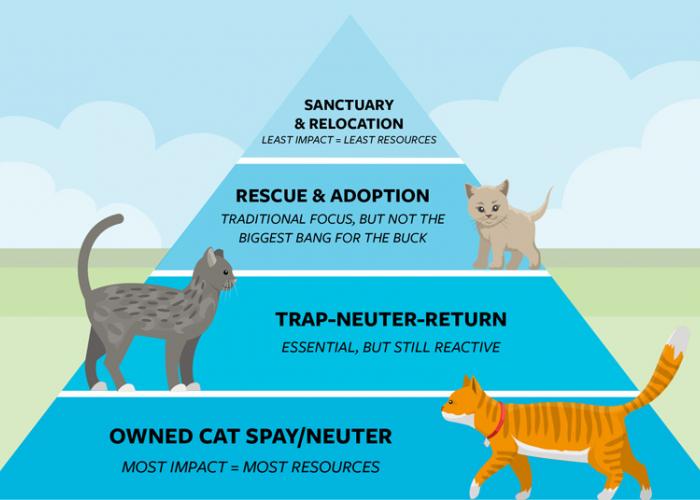How to: Build catio culture in your community
Large or small, catio tours have impacts that extend far beyond the events themselves

In recent years, hundreds of strangers have flocked to Jennifer Hillman’s home in North Seattle. They drive through a neighborhood of tree-lined streets between Interstate 5 and the Puget Sound, park in her gravel driveway and follow a path to the back of the house.
Seated on her back deck, Hillman greets her visitors and answers their questions. People snap pictures. Some pull out legal pads and measuring tapes.
Hillman, vice president of wildlife protection for Humane World for Animals, doesn’t live in a mansion. No famous person once lived in her home. Her yard, which measures about a sixth of an acre, contains no manicured shrubs, rare blooms, tiered fountains or sweeping vistas. What it does have is five catios (aka enclosed “cat patios”) where Hillman’s six cats can lounge in the sun, watch birds winging by and feel the wind in their whiskers.
It started with one small enclosure 20 years ago, which Hillman built with help from friends and family soon after purchasing her home. Before then, her cats were indoor-outdoor, but she wanted to change that—for the sake of her pets, local wildlife and any neighbors who might not appreciate feline visitors.
“It's an opportunity for cat owners to unite. We don't have a cat park we can take our cats to; we have catio tours.”
—Cynthia Chomos, owner of Catio Spaces
Over the years, as her catio complex expanded, so did Hillman’s aspirations for it. In 2015, she helped launch the Seattle Catio Tour, an annual event where her creation and others inspire other cat owners in her community—demonstrating an alternative to letting pets roam freely outside.
As Hillman discovered, plenty of people are interested. After the first Seattle tour, the real estate website Zillow sent a camera crew to film her orange tabby Little Lord Fauntleroy scampering through his catio domain. More than 100,000 people have viewed the video, and nearly 2,000 have attended the tour in person.
Visiting homes with enclosures that range from the utilitarian to the elaborate, participants see the myriad ways people have incorporated catios into spaces large and small, mingle with other cat lovers in their community and watch happy felines reveling in their outdoor enclosures.
There’s a real “joy factor” in these events, says Cynthia Chomos, owner of Catio Spaces design company and a founding member of the Seattle tour. “It’s an opportunity for cat owners to unite. We don’t have a cat park we can take our cats to; we have catio tours.”
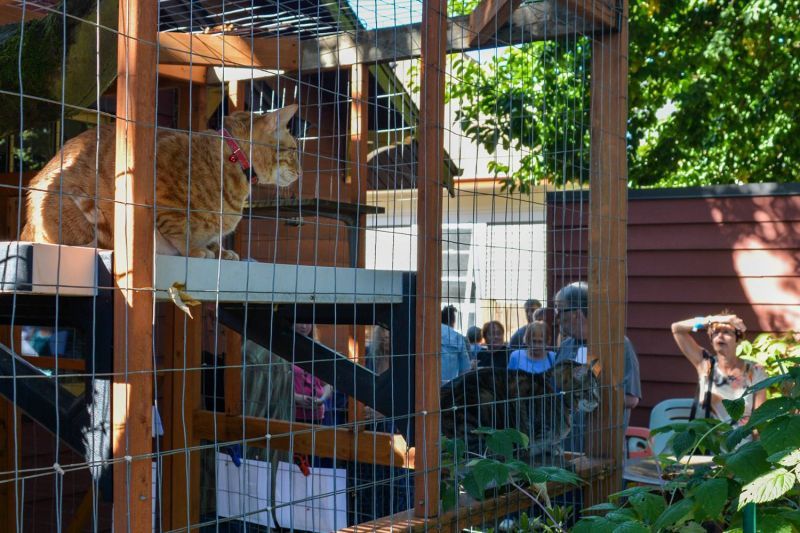
Solving the indoor-outdoor dilemma
Portland was the proving ground for the catio tour concept, an idea that originated in 2013 when Karen Kraus, executive director of the Feral Cat Coalition of Oregon, met with staff at Portland Audubon to brainstorm strategies for their joint education and outreach program called Cats Safe at Home.
Kraus had a catio and knew other people with them. She also knew that backyard chicken coop tours were popular in her city. So, she threw out the idea: What if we do a catio tour?
“Audubon thought it was strange,” she says, “but they’d done a backyard habitat tour so they had experience.”
Later, as the event date neared, Kraus herself started to have second thoughts. “Some radio station got wind of it and did an interview. I was really anxious and thought they were going to make fun of ‘weird Portland people.’”
But when nearly 700 people registered, she and her Audubon partners knew they had a winner. Year after year, the number of attendees grew, topping 1,400 in 2019. Meanwhile, word spread, and catio tours began popping up in cities across North America, from Gainesville, Florida, to Nova Scotia, Canada.
Most are organized by community cat groups, animal shelters and wildlife organizations, working together toward a shared goal: “The whole reason is to motivate people to keep cats safe at home,” Kraus says.
And they work. The Portland tour, which typically includes about a dozen locations, has never had to repeat a host property. That’s because many attendees end up serving as hosts on future tours, eager to show off their new creations.
Through host applications and questionnaires, Kraus and her colleagues have identified more than 600 catios in the Portland metro area. Equally gratifying, Kraus says, is the feedback from local realtors: “We’ve definitely heard from the real estate market that catios are a popular feature on homes and they’re seeing more of them than ever.”
For the animal welfare community, the benefits of a growing catio culture are manifold. Fewer pet cats allowed to roam freely outside means fewer lost pets coming into shelters, fewer injured wild animals flowing into rehab facilities and fewer calls to animal services. Happy, stimulated cats who can safely experience the outdoors are also less likely to be surrendered to a shelter due to behavior problems, says Chomos.
With catio tours, organizations reap the extra benefits of jumpstarting partnerships between wildlife advocates and other humane organizations and increasing their public profile. “You’re going to attract new supporters,” Kraus says, “people that you didn’t even know were interested in cats or wildlife.”
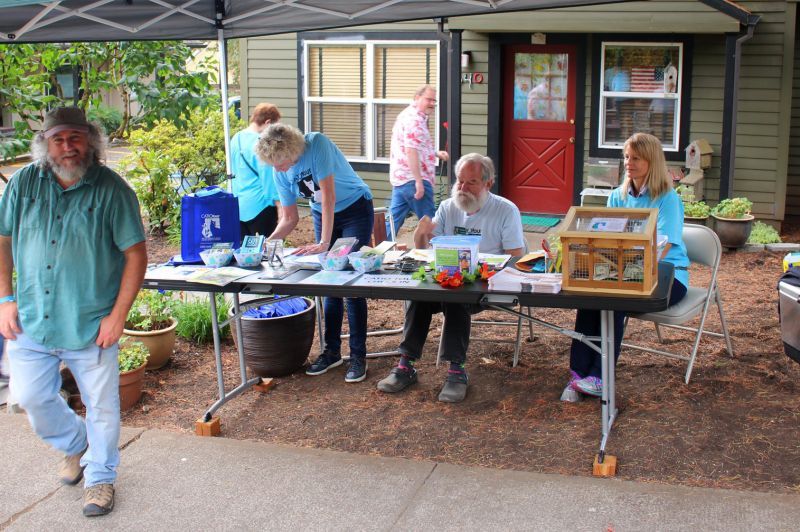
Organizing a tour
Most tours follow a self-guided, open-house-style format in which participants, equipped with a map and details on the host properties, visit as many locations as they want in the order that works best for them.
Within that loose structure, there’s a lot of room for creativity. “It doesn’t have to be like anybody else’s tour,” Kraus tells organizations that are contemplating their own event. “Each city has its own culture. That’s how you make it your own.”
In bike-friendly Vashon Island, Washington, attendees can cycle to the host properties on electric bikes provided by tour co-sponsor Vashon Adventures. In Halifax, Nova Scotia, tours aren’t limited to backyards, says Cindy Murphy, treasurer of the Tuxedo Party of Canada Cat Welfare Society, which coordinates the event. “Because we’re Nova Scotia and everyone is hospitable, people come into your home. We have refreshments like cat cookies and spend some time socializing.”
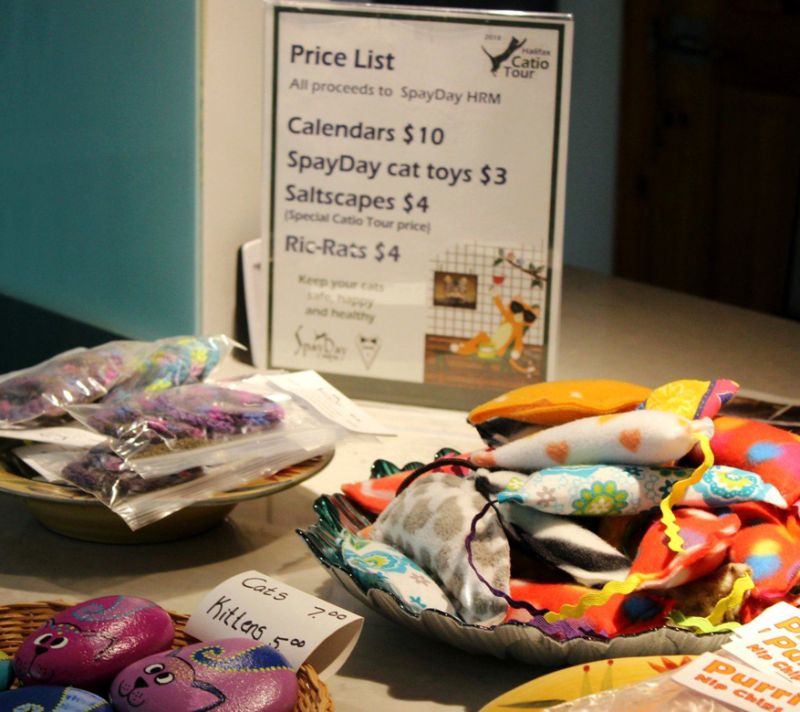
Some tours include quizzes with prizes, information tables showcasing the work of partnering organizations, and even Q&As with professional designers and builders. Portland sells tour guidebooks with glossy photos and construction details on the featured catios; Halifax sells cat toys and calendars. Raffles, donation jars and event sponsors are other popular ways to help cover expenses and boost net fundraising.
It doesn’t cost much to hold a tour, and with enough volunteers, it can be a significant fundraiser, says Kraus, adding that the Portland tour typically grosses about $20,000. Just keep in mind that like most public events, there’s a fair amount of planning and behind-the-scenes work. A smooth registration system and sufficient volunteers are crucial to ensure that people leave your tour feeling inspired, not frustrated.
For Portland, which holds its tour in the fall, the work begins each spring, when it puts out a call for host applications. Organizers visit the prospective properties, evaluating not just the catio structures but available parking space, safe access to the property, proximity to other locations on the tour and the homeowner’s enthusiasm for chatting with visitors.
Ideally, you want to have a mix of catios that demonstrate a range of sizes, styles and features. “We like to say that our tour has catios that go from frugal to fabulous,” Kraus says. “I think it’s important for people to see what they could afford or what they could build, but then like most tours, people want to dream.”
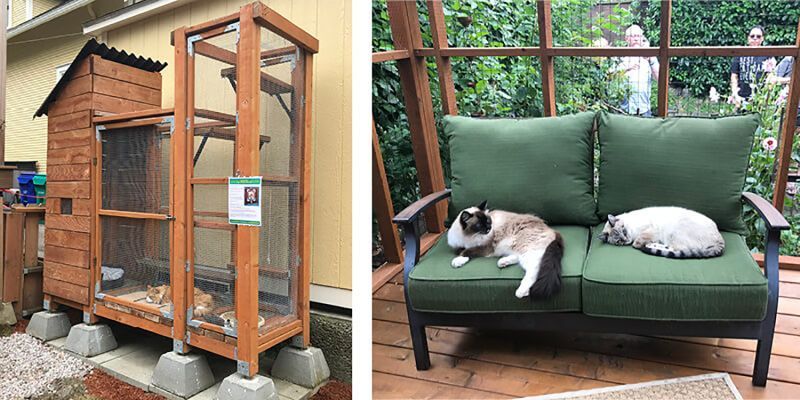
Being creative—and adaptable
Finding a mix of catios that are within easy driving distance of one another and whose owners are willing to welcome strangers onto their properties is typically the biggest challenge for first-time tours.
Kraus’ advice: Don’t be daunted or afraid to start small. “No matter what another group is doing, don’t compare it to others. All of us start with a first time.”
When the Tuxedo Party was planning its first tour in 2018, “we wanted to have some control over it, so we used catios of friends, people we knew and trusted,” Murphy says. The first year, they had four host properties and 42 attendees, including “very serious catio builders looking for ideas.”
The second year, registrations increased to about 60—a good turnout for an area with a relatively small population, Murphy notes. “We actually couldn’t handle any more and stopped selling tickets. The second year was people we’d never met before; we were really excited about that.”
Operation Catnip in Gainesville also launched its tour in 2018, in partnership with the Humane Society of North Central Florida and the Alachua Audubon Society. “We had to scrounge for our catios,” admits Melissa Jenkins, operations director at Operation Catnip. “We had to take what we could get.” That meant including a yard with cat fencing among the six featured properties. “It’s not an enclosed space, but it keeps cats in,” Jenkins says. “Think very broadly about what a catio is, and you’ll find you have more catios than you think.”
Creative thinking became essential in 2020, as COVID-19 and West Coast wildfires forced many tour organizers to scale back their events or find a new format. Portland held a virtual tour last year, featuring prerecorded videos and live Q&As with hosts and a contractor. This year’s tour included eight homes with the option of attending in-person or online.
The virtual format allowed people outside the area to participate, Kraus says, and attendees were willing to pay more for the remote option. Still, she cautions anyone contemplating a virtual tour that you need skilled volunteers to produce the videos and troubleshoot the inevitable computer glitches or you need the money to pay professionals. “You have to have some really techie people, ones who like that stuff,” Kraus says. “If you don’t have that, run away.”
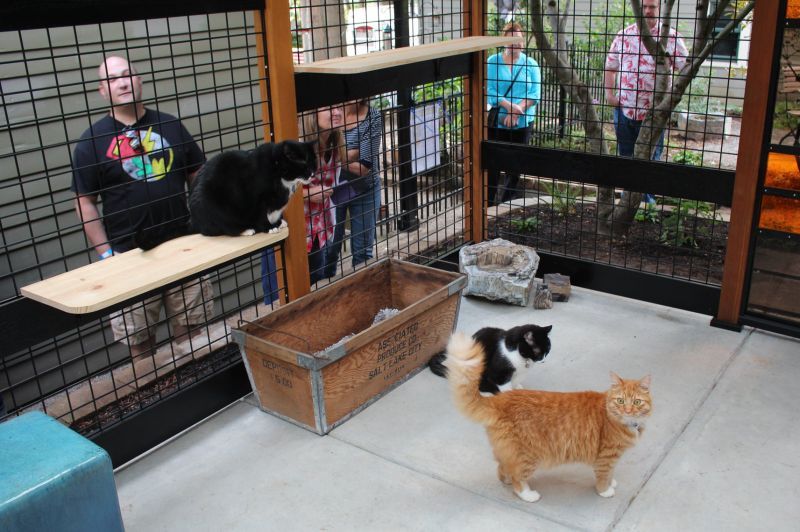
Seattle, which canceled its 2020 tour, did a smaller, informal version this summer, which it marketed on neighborhood community boards as a free open house. About 125 people visited Hillman’s and Chomos’ properties, where they checked out a variety of catio styles and features such as tunnels, litter box extensions and window boxes. Nearly all the attendees were new to the catio concept, Chomos says, and the tour also resulted in “lots of engaging online conversations between neighbors about cat safety.”
It’s this kind of engagement that gives catio tours an impact that extends beyond the event itself. Regardless of size or format, catio tours tend to attract a lot of free press, Chomos says, and with some minimal marketing efforts—such as submitting press releases, posting flyers at vet offices, and asking hosts, volunteers and sponsors to share the event on social media—you can keep the catio conversation going throughout the year.
Six years after the Seattle tour launched, Chomos sees the impact on her neighborhood social networking sites. Now, whenever someone posts about a lost cat, a deceased cat on the roadside or a complaint about a neighbor’s cat stalking a bird feeder, residents inevitably chime in with information about catios and a message of “Hey, here’s a solution.”
As the buzz around catios continues to grow, Kraus envisions a day when outdoor cat enclosures are as coveted in home design as marble countertops, open floor plans and wraparound porches.
“We want this to become the norm,” she says, “and make catios the thing to have.”





